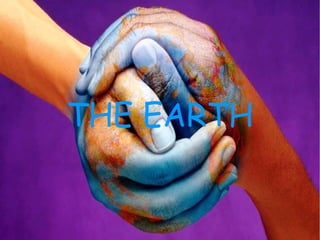
THE EARTH
- 1. THE EARTH
- 2. The Earth Earth, also known as the world, Terra, or Gaia, is the third planet from the Sun, the densest planet in the Solar System, the largest of the Solar System's four terrestrial planets, and the only celestial body known to accommodate life. It is home to about 8.74 million species. There are billions of humans who depend upon its biosphere and minerals.
- 3. Formation of the Earth Earth was formed around four and a half billion years ago. Within its first billion years, life appeared in its oceans and began to affect its atmosphere and surface, promoting the proliferation of aerobic as well as anaerobic organisms and causing the formation of the atmosphere's ozone layer.
- 4. Composition and structure Earth's lithosphere is divided into several rigid segments, or tectonic plates, that migrate across the surface over periods of many millions of years. Over 70% percent of Earth's surface is covered with water, with the remainder consisting of continents and islands which together have many lakes and other sources of water that contribute to the hydrosphere. Earth's poles are mostly covered with ice that is the solid ice of the Antarctic ice sheet and the sea ice that is the polar ice packs. The planet's interior remains active, with a solid iron inner core, a liquid outer core that generates the magnetic field, and a thick layer of relatively solid mantle.
- 5. Composition and structure Earth is a terrestrial planet, meaning that it is a rocky body, rather than a gas giant like Jupiter. It is the largest of the four terrestrial planets in size and mass. Of these four planets, Earth also has the highest density, the highest surface gravity, the strongest magnetic field, and fastest rotation, and is probably the only one with active plate tectonics.
- 6. Other objects interacting with the Earth Earth gravitationally interacts with other objects in space, especially the Sun and the Moon. During one orbit around the Sun, the Earth rotates about its own axis 366.26 times, creating 365.26 solar days, or one sidereal year. The Moon is Earth's only natural satellite. It began orbiting the Earth about 4.53 billion years ago.
- 7. Shape The mass of the Earth is approximately 5.98×1024 kg. It is composed mostly of iron, oxygen, silicon, magnesium, sulfur, nickel, calcium, and aluminium. Due to mass segregation, the core region is believed to be primarily composed of iron, with smaller amounts of nickel, sulfur, and less than 1% trace elements.
- 8. Layers The Earth is divided into layers: the Lithosphere, the Crust, the Upper Mantle, the Mantle, the Asthenosphere, the Outer Core and the Inner Core.
- 10. Pollution Clouds of choking smog; beaches coated in oil; rivers turned red by chemicals. All of these are obvious examples of pollution. However, not all types of pollution are easily seen. For example, invisible plumes of gas may drift over our towns and cities. They can cause asthma and chest problems. They can also kill trees.
- 11. Pollution Another problem is finding out the size of the area affected. Winds can blow pollutants across thousands of kilometres, from one side of an ocean to the other. Chemicals flowing down large rivers can pollute many countries on their way to the sea.
- 12. Effects of pollution 1. Environment Degradation. 2. Human Health. 3. Global Warming: The increase in CO2 leads to melting of polar ice caps which increases the sea level and pose danger for the people living near coastal areas. 4. Ozone Layer Depletion: Ozone layer is the thin shield high up in the sky that stops ultra violet rays from reaching the earth. As a result of human activities, chemicals were released into the atmosphere which contributed to the depletion of ozone layer.
- 13. We must help the world! Greenpeace is an independent global campaigning organisation that acts to change attitudes and behaviour, to protect and conserve the environment and to promote peace. It is present in 40 countries across Europe, the Americas, Asia, Africa and the Pacific. Greenpeace exists because this fragile earth deserves a voice. It needs solutions. It needs change. It needs action.
- 14. The Big Bang The Big Bang Theory is the leading explanation about how the universe began. At its simplest, it talks about the universe as we know it starting with a small singularity, then inflating over the next 13.8 billion years to the cosmos that we know today. The Big Bang theory speculates that out of a great chaotic explosion came all of the order and complexity that we see around us today, with no intelligence required to plan out, design or build anything.
- 16. In some years... If we continue with pollution live won´t be possible because the clima won´t be appropiate. We wouldn´t be able to breath and if the ozone layer continues breaking like it´s doing now in some years we will disappear.
- 18. Videos The Earth - http://www.youtube.com/watch?v=JGXi_9A__Vc The Big Bang - http://www.youtube.com/watchv=wNDGgL73ih Y